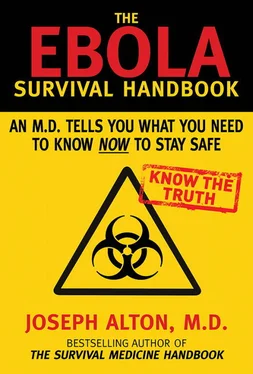ELISA
If you are infected and have survived long enough to begin developing immunity, Enzyme Linked Immunosorbent Assay (ELISA) tests can be useful in detecting Ebola. There are two varieties, immunoglobulin M (IgM) and immunoglobulin G (IgG), and both can show specific and accurate results.
PCR
This test (officially known as “reverse transcriptase polymerase chain reaction” or PCR) is used to detect genetic material from the virus and can pick up very small quantities. That means it could be a good tool for early detection but that it can come back falsely negative during the first three days of infection.
VIRUS ISOLATION
Virus isolation can be effective but can be dangerous and should only be done in lab with high-level biosafety (level 4) conditions firmly in place. Due to the inherent risks involved in culturing and replicating Ebola, even in a controlled environment, this type of test is more difficult to perform. Instead of being used to examine the situation of one patient, it can be used in research to better understand Ebola, leading to effective treatment drugs and, eventually, a vaccine.
Various other tests that determine the state of your blood, especially clotting factors, and the function of various organs will be performed.
TREATING EBOLA
There is no cure for Ebola as of the time of this writing. However, patients have been documented to make full recoveries based solely on “supportive therapy,” which encompasses measures taken to balance fluids and electrolytes, maintaining oxygen status and blood pressure, and working to avoid any complicating infections. It is well documented that patients who are hospitalized, in general, do better than those in West Africa that are turned away due to lack of bed space. Even the prevention of dehydration with simple IV fluids may improve the chance of recovery.
The Food and Drug Administration (FDA) has not yet officially approved a drug or vaccine as effective against the Ebola virus. However, there are a number of very promising agents that will, hopefully, be available soon. Even so, the question of how fast large quantities can be manufactured exists. And if there are limited amounts of vaccine or treatment, who gets it and who doesn’t?
ZMAPP
The treatment receiving the most attention is called “ZMapp.” ZMapp has been credited with aiding the recovery of several missionaries evacuated to the United States after being infected in West Africa.
ZMapp therapy consists of three “monoclonal antibodies” that are designed to treat existing Ebola infection. These antibodies work by binding to proteins in the virus and “targeting” them for destruction by the immune system.
To explain simply how ZMapp is made, a mouse is injected with Ebola. It produces antibodies against the viruses, which are taken and combined with human cells. Now you have cells with genetic material from two species (called a “chimera” after a mythological beast made up of parts of different animals). These cells, theoretically, have the capacity to fight the virus. They are cloned to make a serum that is given to Ebola victims. It’s more complex than this, but this is an easy, simple description. Interestingly, the process uses tobacco plant material in production.
The serum has been successful in monkeys and may have been a factor in the recovery of some of the test subjects. The question being asked, however, is did the patients recover due to ZMapp, or was it due to their evacuation to high-level medical facilities or some genetic resistance to the virus?
Other drugs such as Tekmira are also in development in the FDA pipeline.
SURVIVOR BLOOD
There’s also a growing movement to use whole blood or plasma from recovered Ebola patients in the treatment of Ebola sufferers. These survivors have antibodies which have successfully fought the virus. It is not proven to be effective, but is promising enough that it has spawned a burgeoning black market in Ebola survivor blood in West Africa.
AN EBOLA VACCINE?
While an FDA-approved Ebola vaccine isn’t yet available, The National Institute of Allergy and Infectious Disease (NIAID), a division of the National Institutes of Health (NIH), is currently evaluating two candidates under serious consideration. A statement from the WHO on September 2, 2014, after a summit that brought together nearly two hundred experts, declared that they had discussed “several therapeutic and vaccine interventions that should be the focus of priority clinical evaluation at this time [and that]… a number of candidate vaccines and therapies have been developed and tested in animal models and some have demonstrated promising results. In view of the urgency of these outbreaks, the international community is mobilizing to find ways to accelerate the evaluation and use of these compounds.”
Basically, it’s about safety in humans versus possible adverse side effects. The current thinking is that the benefits of an effective vaccine outweigh the risk of side effects. When the safety issues are resolved, it is highly possible that the Ebola vaccine will become available relatively soon, first to health workers and then to the general public.
TIP
The WHO warns that you still need to remain cautious about the possibility of infection and not assume that a cure is forthcoming.
SHORT SUPPLY
In addition to the vaccines, the summit discussed the experimental drugs already available, though not in large enough quantities as of yet. As the statement explains, “Existing supplies of all experimental medicines are limited. While many efforts are underway to accelerate production, supplies will not be sufficient for several months to come. The prospects of having augmented supplies of vaccines rapidly look slightly better.”
They also warn that “…investigation of these interventions should not detract attention from the implementation of effective clinical care, rigorous infection prevention, and control, careful contact tracing and follow-up, effective risk communication, and social mobilization, all of which are crucial for ending these outbreaks.”
Although treatments and vaccines are under development, it still isn’t likely that you can buy it at your local pharmacy anytime soon. The WHO warns that you still need to remain cautious about the possibility of infection and not assume that a cure is forthcoming.
OTHER COMPLICATIONS OF EBOLA
If Ebola proves fatal, death will occur within a week or two of the first symptoms, usually due to organ failure. If a patient survives Ebola, improvement will begin to show about two weeks after symptoms manifest.
If you are lucky enough to survive a bout with Ebola, you may still be faced with other complications for days, months, or longer. Due to its highly insidious nature, Ebola can take a toll on the body in many ways, including extreme weakness and fatigue, headaches, hair loss, chronic liver inflammation, sensory changes, and damage to certain organs. Hair and skin loss may occur as a possible result of infected sweat glands.
Also, the virus may yet persist for some infected through bodily fluids such as semen and breast milk—in some studies for up to three months. This means while the patient has been “cured,” the disease can still be transmitted through sexual contact or breastfeeding months later. In 2000 in Uganda, two children died of Ebola after being breastfed by mothers who had recently recovered from the disease.
MORE HIGHLIGHTS FROM THE WHO SUMMIT
In September 2014 at a meeting of more than two hundred WHO leaders and Ebola experts, it was determined that the current Ebola epidemic is “the most severe acute public health emergency seen in modern times. Never before in recorded history has a biosafety level four pathogen infected so many people so quickly, over such a broad geographical area, for so long.”
Читать дальше



![John Stieber - Against the Odds - Survival on the Russian Front 1944-1945 [2nd Edition]](/books/405234/john-stieber-against-the-odds-survival-on-the-russian-front-1944-1945-2nd-edition-thumb.webp)








